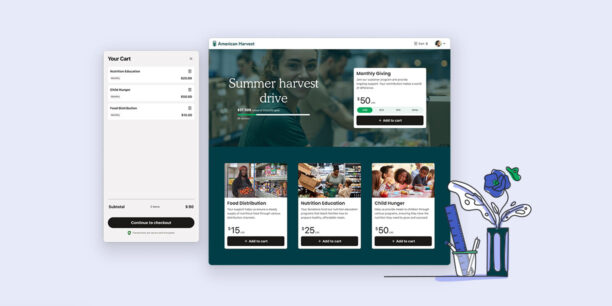Capital Campaigns: Trends and Tips You Need to Know

Request a Demo
Learn how top nonprofits use Classy to power their fundraising.
If your nonprofit is looking to make a big investment in a particular project, you may have wondered if launching a capital campaign is the right path for you. Capital campaigns are time-limited efforts with a large fundraising goal for a specific need. They typically have four phases of implementation:
- Planning: includes setting a budget, gathering volunteers, setting your goals, and researching prospective donors
- Quiet phase: includes securing major donors to raise 50 to 70% of your fundraising goal
- Public kickoff: includes launching your campaign to a wider audience, announcing your goal, and fundraising the remainder with smaller donations
- Wrap-up: includes thanking your donors and making plans to share updates as you put their donations to work
Hospitals and universities often use capital campaigns to fund big projects like land acquisition, equipment purchase, or construction projects, but other nonprofit sectors can also benefit from their major gift focus. A capital campaign could be what your nonprofit needs to take your mission to the next level and actualize your strategic plan.
Read Next: The 4 Phases of a Modern Capital Campaign
Below, we’ll help you to prepare for your next capital campaign by sharing five trends on how the campaigns are run and four tips for how to implement yours effectively.
5 Trends to Know With Capital Campaigns
Technology advances, changes in communication practices, and other factors have impacted capital campaigns over time. Knowing the trends that have changed and stayed the same can inform your planning process.
1. Consultants and Volunteers Are Easier to Engage
With the rise of video conferencing software and other digital forms of communication, it can be easier to engage your capital campaign team. While nonprofits may have relied on getting everyone in the same conference room in the past, they now have access to a wider network of potential volunteers and consultants.
Simple Steps to Elevate Your Video Conferencing Tools
If someone on your board knows an expert willing to help you out, but they live on the other side of the country, there’s now less need to account for an expensive travel budget. As you plan for who you want on your team, cast a wide net. It helps to have some local champions, but don’t rule out external expertise that might bring a fresh lens to your campaign.
2. Communication Channels Have Changed
Historically, capital campaigns focused on hard copy materials, such as glossy brochures and printed case statements. However, it has become more common for nonprofits to focus on their online materials to communicate their capital campaign message.
6 Quick Tips to Unify Your Offline and Online Fundraising
While you may have some major donors who still want a printed copy of your annual report, feasibility study, or other materials, the budget you need for this piece of your capital campaign can be much lower than in the past. Instead, focus on clear online branding on your website, social media, and campaign pages. Create digital flipbooks and other online versions of your marketing materials that you can quickly and easily share with prospective donors.
3. Online Campaigns Increase Reach and Tracking
Across age demographics, donors prefer to give online. Now that online campaigns are common and easy to use, you have access to a wider audience when you launch the public phase of your campaign.
10 Proven Tips to Supercharge Your Online Fundraising Campaigns
While you may still use some events, direct mailing, or other strategies as part of your fundraising effort, the bulk can come from your online campaign page. This adds ease to the public phase of your capital campaign, as you can largely rely on the strategies you already implement for your other annual campaigns.
Your online campaign page also adds a layer of transparency and tracking toward your goal. With real-time updates, your supporters can see how close you are to meeting your goal, and you can gauge where and when to make a bigger push to get there.
4. Focus Remains on Major Gifts
While technology has changed some trends in capital campaigns over the years, one trend remains constant. What makes capital campaigns stand out is their focus on obtaining major gifts as the driver for their success.
Eighty to 90 percent of a capital campaign’s donations still typically come from 10 to 20 percent of the total donors to the campaign.
5. Donors Will Still Give During a Crisis
The COVID-19 pandemic left some uncertainty with how individual donors and corporate sponsors would respond. While some companies did have to cut back their philanthropy budgets, others took the crisis as a reason to give more. Some giving circles in 2020 found that over 75% of their donors planned to maintain or increase their philanthropic contributions that year.
Trends have shown that keeping corporate partners engaged during a crisis and maintaining communication with your supporters can lead to continued progress even during challenging times.
6 Ways to Keep Corporate Partners Engaged During COVID-19
Additionally, since capital campaigns often take multiple years to plan and fully execute, beginning the process during more challenging fundraising times shouldn’t be a worry. Planning ahead during a downturn can set your campaign up for a successful launch once the economy has recovered and businesses and individuals are able to give more freely to causes again.
4 Tips for Making Your Capital Campaign a Success
Now that you know the trends of implementing a capital campaign, there are a few best practices that can elevate your success.
1. Tell a Great Story
As with other campaigns, your capital campaign ask should center around a story. Show your supporters why this fundraising effort is so important by highlighting the people you’ll be able to serve, the impact you’ll make in the community, and how you’ve demonstrated your ability to do so in the past.
Download the Guide to Nonprofit Storytelling
Storytelling allows donors to form an emotional connection with your cause. Especially when fundraising for a major goal, you want your supporters to be able to see the story behind the dollars and how their gift makes them a part of that story. Client testimonials, video messages, inclusive language, and impact data are all some of the features to consider in your storytelling.
2. Focus on Donor Stewardship
The public phase of your campaign actually starts before it’s public. Active donor stewardship throughout the planning process helps to ensure a more successful public phase. If you’re already building relationships with donors before your public launch, you won’t need to play catch-up convincing them why they should support your organization after you launch. Instead, they will have already formed a connection to your nonprofit and cause.
Creating volunteer opportunities, sending video thank you messages to donors, and connecting with supporters over social media are just some of the ways you can build these relationships.
3. Create a Brand Around the Campaign
Your capital campaign is a massive undertaking, and you want supporters to be able to quickly and easily identify it. Creating a specific brand around your capital campaign helps to differentiate it from other fundraising efforts and signal its importance.
You can create a specific logo or slogan to associate with your campaign. Also consider any specific imagery you may want to use that showcases your goal. Use the same color palette, fonts, and other branding for all related marketing materials.
Creating a campaign specific page on Classy will also help you to track progress toward your specific goal and differentiate it from other fundraising pushes. You’ll be able to incorporate the branding you’ve established for your capital campaign onto your Classy campaign page to ensure it’s recognizable as part of the effort.
4. Give Yourself Ample Time
Capital campaigns are used to fund big goals, and, like big goals, planning for them takes time. Your start-up phase will involve gathering volunteers, assigning roles to staff, creating campaign materials, completing a feasibility study, and more. The quiet phase of courting major donors can also take around a year to secure those big partnerships.
To run a successful capital campaign, remember that it will take time, so have a long-term view for your nonprofit as you get started and know it’s alright to build in some breathing room.
Fund Your Nonprofit’s Next Big Project With a Capital Campaign
A capital campaign is a major project for nonprofits, but the effort required to run one successfully can pay off in allowing you to take on big, mission-driven work. Knowing the trends and best practices of capital campaigns will get yours off to a great start.

The State of Modern Philanthropy 2021
Subscribe to the Classy Blog
Get the latest fundraising tips, trends, and ideas in your inbox.
Thank you for subscribing
You signed up for emails from Classy
Request a Demo
Learn how top nonprofits use Classy to power their fundraising.
 Explore Classy.org
Explore Classy.org 

